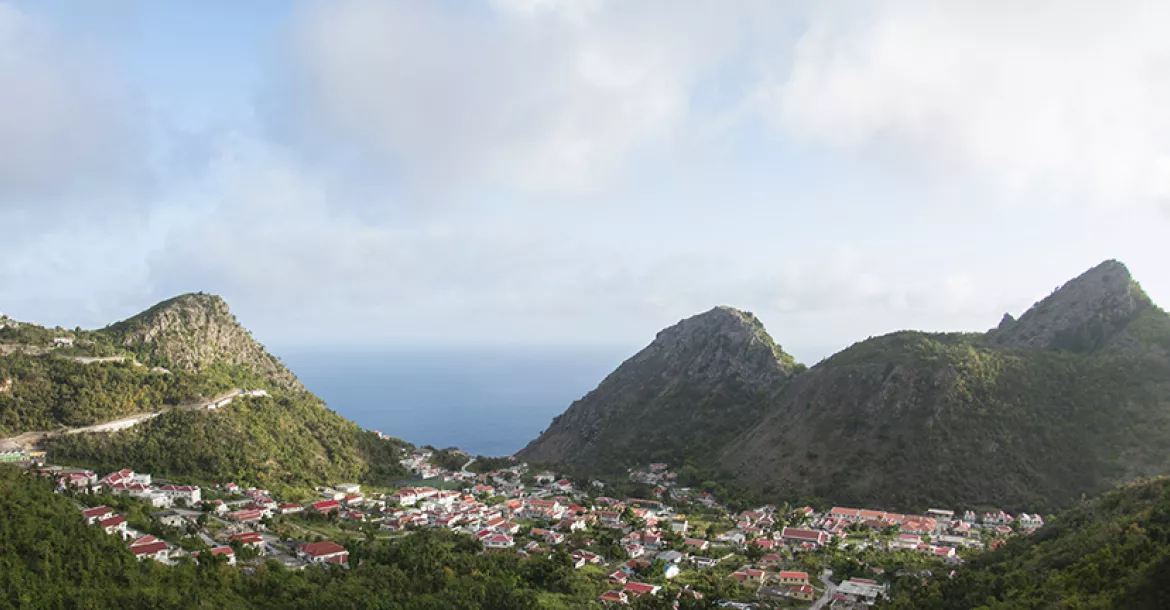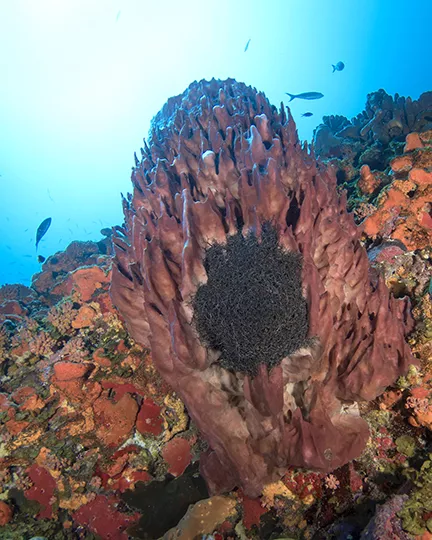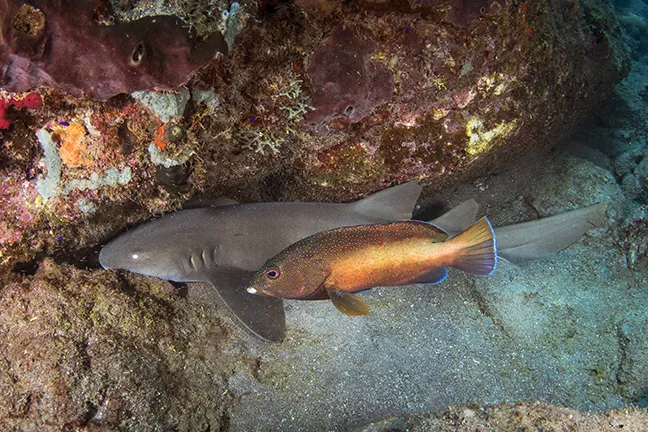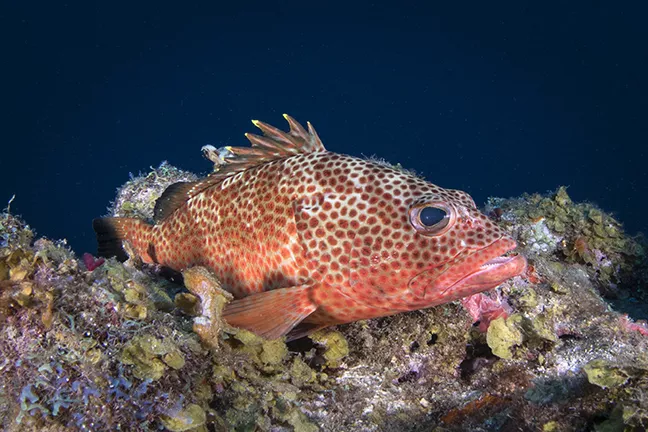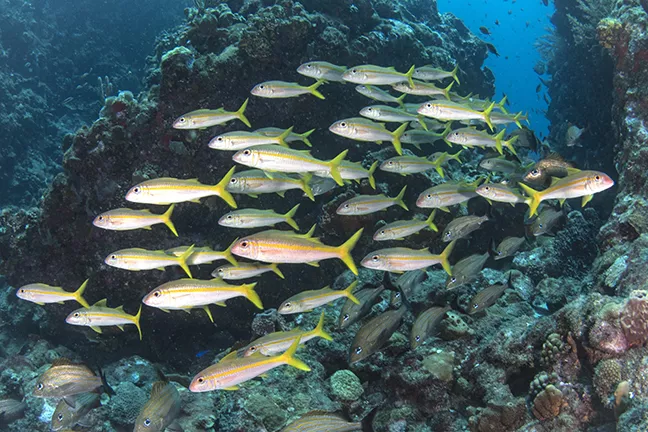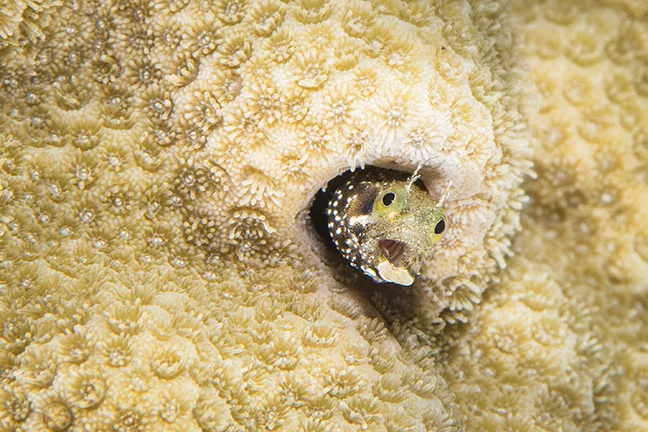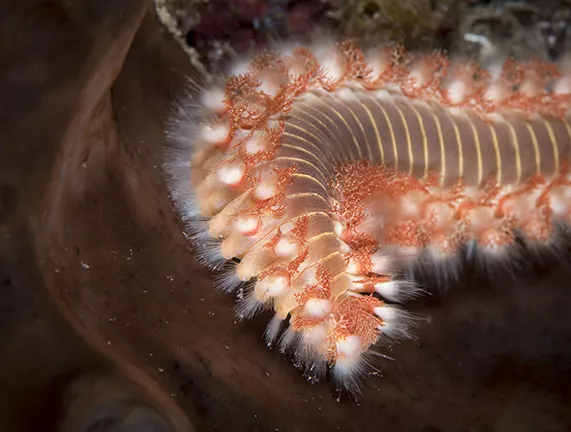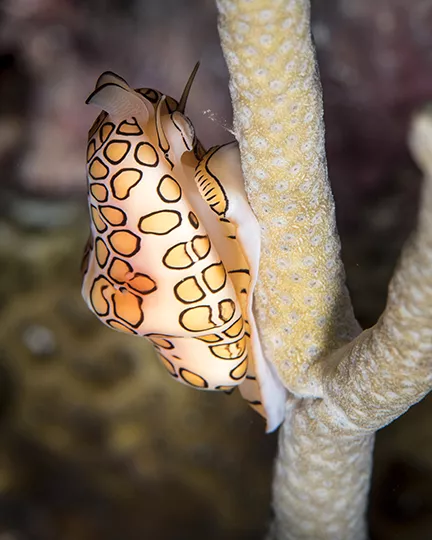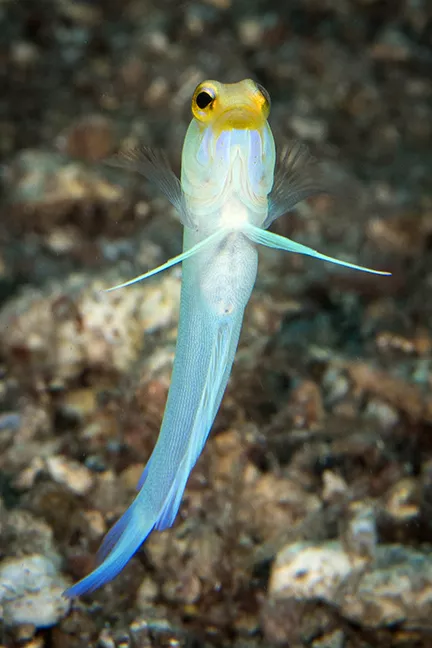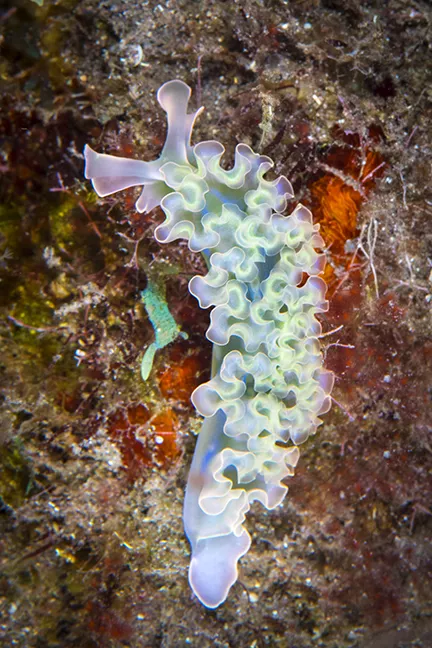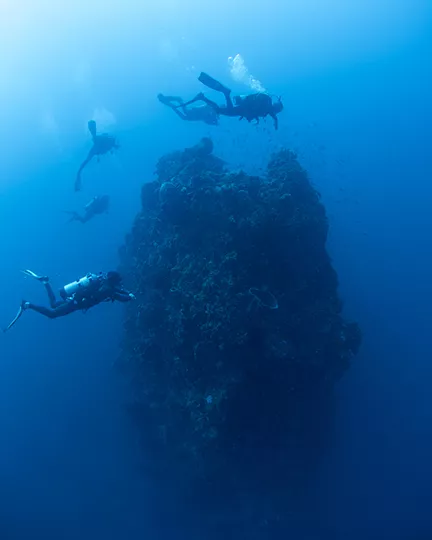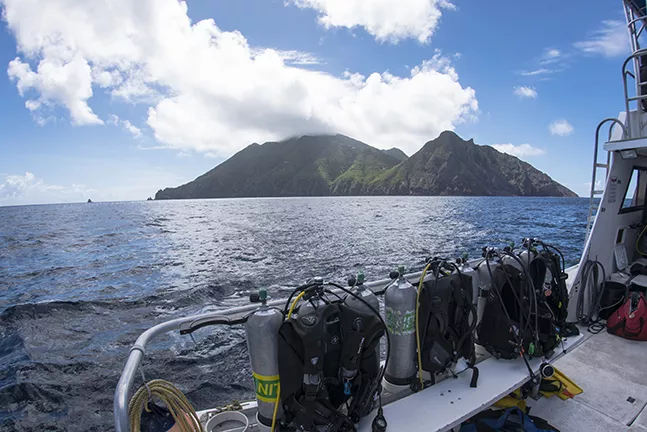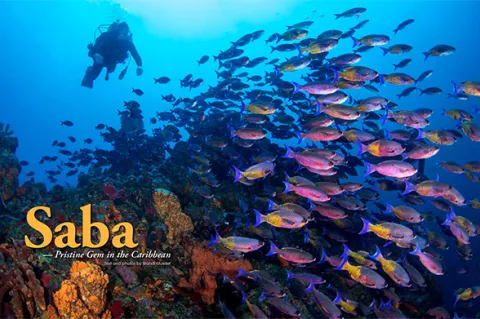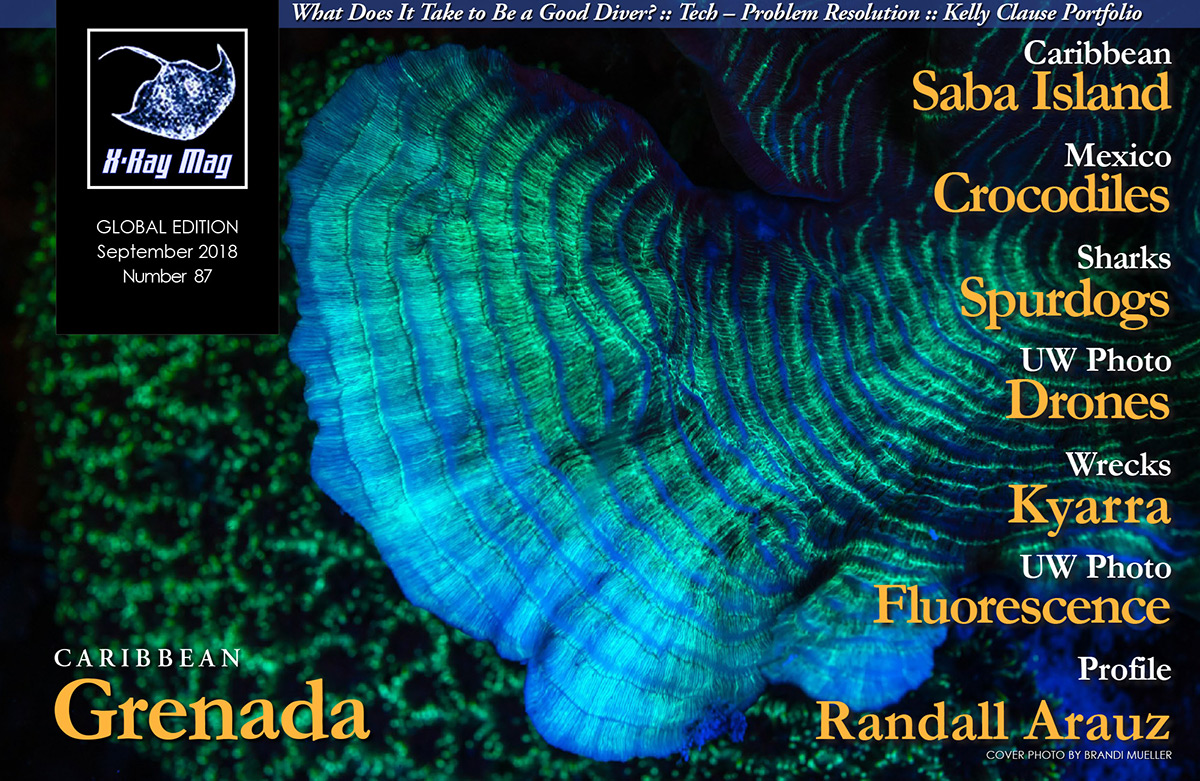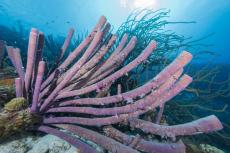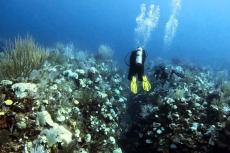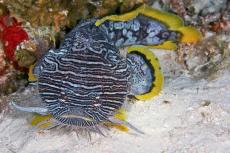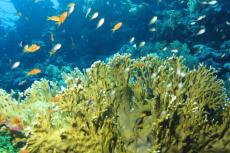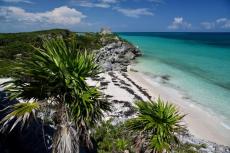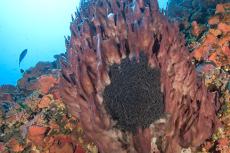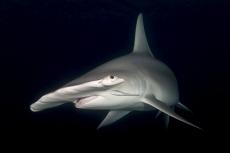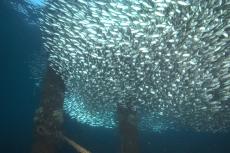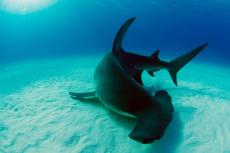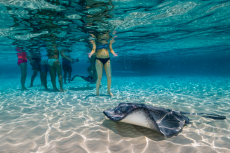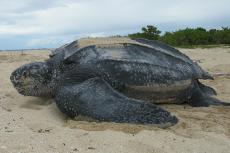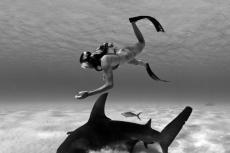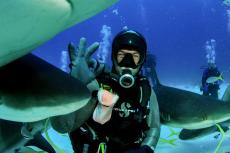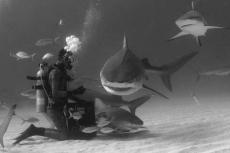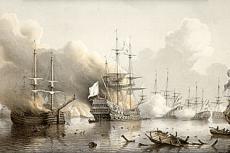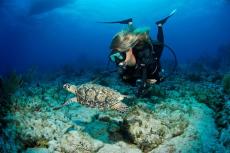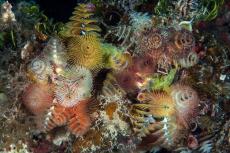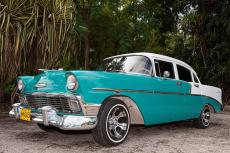I loved Saba before I arrived. Throughout my dive travels, I had occasionally heard about this mythical island of which not many knew. Tales of a small dormant volcanic island with healthy reefs, hiking trails crisscrossing its eight square kilometers, and excellent food. Those who had been there raved about the “Unspoiled Queen,” the name islanders and visitors had given the island, and it was added to my bucket list with a few stars next to it.
Contributed by
Factfile
Brandi Mueller is a PADI IDC Staff Instructor and boat captain living in the Marshall Islands.
When she’s not teaching scuba or driving boats, she’s most happy traveling and being underwater with a camera.
For more information, visit: Brandiunderwater.com.
Being in the general vicinity of Saba and having a little free time, I decided to finally make my way to this island, which has lingered in my diving dreams. Officially a special municipality of the Netherlands, Saba is part of the Leeward Islands and Lesser Antilles with St. Maarten to the north, St. Barthelemy to the northeast, with St. Eustatius and St. Kitts to the southeast.
A week prior to my trip, I received a fantastic email from Sea Saba—the operation with which I would be diving—that had all the details I needed (and some I had not considered) to prepare for my trip. It included packing suggestions (with a YouTube packing video link included), underwater photography tips, current water temperature, location tips including currency (US$), internet access (expect it to be slow), and airline weight rules (see packing video to reduce your luggage weight). I clicked over to the website and was blown away with the amount of information on it; it is probably the most thorough dive operation website I have ever seen.
Juliana’s Hotel
After arriving in Saba, I was taken to Juliana’s Hotel in Windwardside, the small village where most of the visitor accommodations and restaurants are. After being shown to my room, the first thing I loved there was the fact that there are no keys at Juliana’s. Each room has a keypad on the door, so there is no need to carry around (and often in my case, lose) keys. My room was very nice and clean, had everything one might need, including a mini refrigerator and coffeemaker, but the best part was the balcony with a view. I spent my free time sitting outside enjoying the sunshine and cool breeze while admiring the ocean view. I could have spent hours out there relaxing and reading, but there was exploring and diving to be done.
After a full day of travel, I arrived quite late at the hotel. My first stop was to check in at Sea Saba, which was just a short walk from the hotel, to confirm my diving plans for the next morning and then I headed back to Tropics Café (the restaurant at Juliana’s) for dinner. The open-air restaurant sits next to the pool but also overlooks the ocean, and serves a variety of fresh seafood, burgers, pasta and more. Exhausted from travel, I went to sleep quite early, ready to dive in the morning.
Getting around
I woke up my first morning in Saba and set up my camera, while enjoying a coffee in my room. It took longer than normal though, because I could not help being drawn to the ocean view out my sliding glass doors where I was about to be diving.
Making my way to breakfast at Tropics Café, I enjoyed homemade granola and yogurt with fruit and honey while anticipating my upcoming dives. I also had my eye on the Saba Spice-drenched French toast on the menu. Saba Spice is a rum-like liquor made with locally grown spices.
At 8:45 a.m., a mini-bus taxi arrived to pick up me and two other guests staying at Juliana’s. As we headed out of town to the harbor, we stopped at the Sea Saba shop, where owner Lynn greeted us and checked to make sure everyone was doing okay, asking if we needed dinner reservations made or anything else. I was pretty impressed with the service already. This would occur every morning on the way to diving and on the way back, and they were happy to help with spa reservations, restaurant recommendations and any other needs we had.
The journey from Windwardside, through The Bottom, and to the harbor takes 10 to 15 minutes. There is only one road on Saba, known as “The Road” which has an interesting history of its own. The extreme terrain of Saba—think jagged cliffs, no flat patches, rainforest and rocky landscape—made it difficult to develop the island. This also led to it being a favorite hideaway for pirates who would escape into the jungle where no one wanted to pursue them.
Dutch and Swiss engineers in the early 1900s claimed a road just could not be built, but a Saban resident, Josephus Lambert Hassell, took a correspondence course in civil engineering and started building the road in 1938. It took until 1958 before it was completed, and driving on the winding, cliff-edge, twisting-and-turning road is an adventure in itself, and provides gorgeous views, which we happily photographed with our smartphones each morning and afternoon, as we made our way to the dive boat.
Our kind and helpful taxi driver, Peddy, not only got us to and from the dive boat each morning, he also would slow down to let us take photos whenever he noticed one of us trying to capture the view on our various forms of photography gear. I believe he told me he was seventh-generation Saban, which is pretty cool, and he was a wealth of Saban history if you asked.
Arriving at the harbor, we made our way to Sea Saba’s boat; they have two 12m (40ft) vessels—the Sea Dragon and the Giant Stride—both customized for scuba diving with tank racks, plenty of storage space, a swim platform right at water level for easy entry and exit into the water. My favorite aspect of the dive boat was that they provided individual cooler bags for cameras, already filled with fresh water to help protect delicate camera gear.
Dive sites
Customs House. Our first dive was at a site called Customs House in Ladder Bay, which is just below 800 stairs cut into the side of the cliff where supplies were once carried from ships up to the Customs House, which is still there. It was often women who carried goods up these stairs because the men were at sea fishing, and things such as a piano and even the Queen were carried up the stairs at one point. Today, it is popular to traverse these steps down to the beach (and back up again).
Glad to not be accessing this dive site via 800 stairs, I took a giant stride (off the MV Giant Stride) into my first dive at Saba. Underwater, the conditions were perfect. No current, the water was around 27°C (80°F), and there was marine life everywhere. Right below the boat was black sand—all of Saba’s dive sites have dark, volcanic sand. Swimming away from the boat, we came upon a huge coral garden loaded with life. Sea fans and sponges colored the area as fish swam around. A small hawksbill turtle emerged seemingly out of nowhere and came to swim among us for a while, and a few reef sharks made themselves known as well.
Man O'War. Going a bit farther around the island, our second dive was at Man O'War. Before each dive, a detailed brief was given, along with a map of the site and a “Fish of the Dive.” The guides told us they had been seeing a lot of juvenile spotted drums, so that was our fish to find. Although this fish is one of my favorites, I was using a wide-angle lens, so I was not trying too hard to spot them.
However, half-way through the dive, our guide gave me the signal for spotted drum (picture someone pretending to play the drums), and then he showed me three fingers. I had to go over and look, and there they were: three perfect baby spotted drums, with their tiny dime-sized bodies and extended black and white dorsal fins. Even though they were too small for my lens, I could not swim away without at least snapping some proof. Back in my room, I was surprised to have gotten a few shots where all three were in focus.
Babylon. On day two of diving, we visited a site called Babylon, so named for overhanging volcanic rock formations that give the illusion of swimming under the Hanging Gardens of Babylon. Saba itself is entirely volcano-formed, and so is much of the underwater terrain. Rocky formations make the dive sites interesting, with canyon-like swim-throughs, mini walls and deep-water pinnacles.
Diamond Rock. Our second dive was at the famous Diamond Rock, which is a lava-formed pinnacle that emerges from the seafloor around 33m (110ft) and out of the water. A popular resting place for birds, their presence has coated the rock with a white substance, making it look diamond-like from a distance. I saw Diamond Rock from the airplane when I flew in, so it was exciting to dive it.
Moored a little way off the rock, we swam underwater towards the structure. The sandy seafloor was patrolled by stingrays. Upon reaching the pinnacle, we started circling it at the deepest point, moving shallower with each additional rotation. I had a moment in this dive when I was trying to photograph a school of goatfish when I saw a turtle swimming close on the other side of me. Bringing my gaze back to the fish school, there was now a reef shark in-between the turtle and the fish, and I saw a large grouper too. There was too much amazing marine life that I did not know where to point my camera (see: #SabaProblems).
We went out for a night dive, leaving the harbor just as the sun was beginning to set. We watched the sky turn orange and pink, and the island itself turn blood orange in the sunset. I was happy I went just to see that. Underwater did not disappoint either. The cryptic teardrop crabs were out in full force. After about ten minutes, I had taken so many photos of them I had to start ignoring them. I also found a flamingo tongue feeding on what looked like the spawn of a sponge. I spent almost 20 minutes watching this mollusk slowly eat its dinner. There were also sleeping parrotfish and bearded fireworms; and while I had my nose glued to the flamingo tongue, other divers saw several sharks cruise by.
Twilight Zone. Saba diving is known for its submerged volcanic seamounts, and on day three, we went to Twilight Zone—one of these pinnacles, with its shallowest point at 25m (85ft). Descending onto these seamounts is really neat because you descend into the open blue without being able to see the bottom until around 30m (65ft). We continued down and down, until we could make out the pinnacle's shadow with fish flitting about.
Sometimes, people argue that there is no fish this deep and not much color, but the seamounts of Saba defy that idea. Coral and sponges carpeted the rock pinnacle and flashlights (or in my case, strobe lights) lit up the deep hues of ginger-orange and deep violet. Eels peeked out from crevasses in the rock, small fish found homes in the serrated rock, and bigger fish swarmed the pinnacle. The only downside of this dive was that our no-decompression time was too short.
Queen’s Gardens Resort & Spa
Midway through my week on Saba, I moved to Queen’s Gardens Resort & Spa located in The Bottom, which is the capital and largest village of Saba. This lovely property sits hillside with a spectacular view of red-roofed, white houses that are nestled within the green valley and ocean beyond. The luxury boutique resort consists of 12 one-floor suites, many with semi-outdoor plunge pools with views of the mountains, valley and ocean.
While checking out the property before dinner, I found myself in their lounge bar, which also had a glorious view of the valley and ocean. Sitting down, I noticed a gin menu. Gin is my post-dive-in-moderation cocktail of choice, and I soon found myself talking with Duco—Queen’s resident artisanal gin creator. While telling me about the 50-some choices of gin available at the small bar on this tiny island in the Caribbean, he put together a spicy chili pepper and basil gin and tonic for me. As if I was not already in love with the island.
After also sampling a lavender gin and tonic, which included an ice cube of infused lavender water, I finally made my way to dinner in the lush garden setting at the center of the resort. I enjoyed all my meals outdoors, which seemed to always be the perfect temperature with a slight breeze blowing, but meals were also available indoors at the elegantly decorated restaurant in case of rain.
The menu changed daily with only a few offerings each night, but with choices like local lionfish and lamb couscous, I pretty much wanted to try them all and stay for several weeks. The restaurant is known for its "flaming wheel of parmesan" pasta parmigiano, which is prepared tableside and includes putting just-cooked pasta into a 72lb wheel of parmesan cheese. I can confirm it was amazing.
Outdoor seating also included two special tables called the Bird’s Nest. This was a single table built into an ancient mango tree, giving diners a splendid view, or dining within the foliage-covered gazebo. These spaces need to be reserved several days or even weeks in advance.
I am not usually one who sleeps well my first night in a new place, but I woke up my first morning at Queen’s feeling like I was at home (after realizing where I was, I thought it was even better than home). Soft light and a gentle breeze filtered through the open windows, and I made a Nescafe in my room. I could not remember the last time I felt so relaxed as I sat on my couch overlooking the valley (through sliding glass doors that opened to let in the ocean air).
I slowly made my way to breakfast and enjoyed a lovely eggs Benedict, listening to the sounds of the forest waking up around me. Soon, it was time to be picked up to go diving. I was now closer to the harbor, so Peddy just picked me up as they passed through The Bottom and took me down to the boat with everyone else.
More dive sites
Third Encounter / The Needle. This was an exciting day because we were diving Saba’s most famous dive site, Third Encounter (or The Needle). This site is actually two seamounts next to each other, with one being the narrower (needle-like) of the two. We descended into the deep and first came to the larger of the two, but immediately headed to the needle. After a three-minute swim in open blue, we could just make out the shadow of the needle.
We were greeted by a massive school of creole wrasse, which tried to seek shelter around us from a giant trevally that was actively hunting them. As it would charge in like lightning, the school would move in unison so quickly we could hear the whoosh sound the school made when moving out of the trevally’s striking range. With the shallowest point being 27m (90ft), we only had a few minutes before having to leave the action. The larger seamount was at 24m (80ft), so we had a few more minutes to explore before having to return to the surface.
Hot Springs. Our second dive of the morning was at Hot Springs, which reminds one that while Mount Scenery has not erupted in almost 400 years, there is still volcanic activity occurring below. In certain areas, divers can bury their hands in the sand and feel the warmth, and some rocks are hot as well.
Sea Saba is a PADI 5-Star Dive Resort and SSI training facility and their dedication to conservation is a great example of what every dive operation should be. I was impressed by the knowledge of all of their staff, from guides to boat captains to those who worked in the office; they are an amazing source of knowledge of all things Saba, ocean and conservation. I found out later Sea Saba is a Reef Field Station, and the staff is trained to at least Level 3 and can help do field surveys; they help with a coral nursery and participate in other research.
Dining
Juliana’s Hotel and Queen’s Gardens both have excellent onsite dining options, but Saba’s dining culture is set up to make it easy to explore the island’s food options. Currently, there are around 13 options, many within walking distance in Windwardside (and from Juliana’s) or a short taxi ride between Windwardside and The Bottom.
Overall, I was very impressed with everywhere I ate. Food was local and fresh; there were options for everyone, including vegetarian and vegan; and always, the menus were exciting with a certain Saba flare.
On more than one evening, I found myself at the Brigadoon, which was a lovely open-air fine dining restaurant that seemed to be everyone’s favorite. It also hosts Sea Saba’s Monday evening presentations, where you can enjoy a cocktail and learn about the history of Saba, its conservation projects, some fun fish facts and a lot more. After listening to the presentation, I stayed for an amazing teriyaki mahi-mahi and chocolate mousse, which was to die for. Later in the week at a fantastic dinner with Sea Saba owners John and Lynn, I also had the fish (which is often locally-caught lionfish) in a white wine sauce, which was brilliant.
Both Windwardside and The Bottom have several surprisingly well-stocked grocery stores. There are many cottages one can rent on Saba, with kitchens, and the grocery stores have anything anyone would need to cook meals on their own or to re-supply a sailboat before continuing to the next island.
Beyond diving
Saba’s diving was some of the best I have seen in the Caribbean, but Saba is not just about diving. There are great hiking trails for all levels of hikers from easy or moderate walks to the steep climb to Mount Scenery, with over 1,000 steps straight up. I settled on the mostly flat Sandy Cruz trail one afternoon after diving. It is not recommended to partake in strenuous activity after diving (or at least, that is my excuse for choosing the flat trail, but definitely do not attempt Mount Scenery after a day of diving).
Sandy Cruz Trail. The Sandy Cruz trail, which takes around two hours, stretches from Hell’s Gate to Troy’s Hill, which was right up the road from Queen’s Gardens. So, I opted to take a taxi to Hell’s Gate and start from there, making just a one-way trip and ending up just in time for a gin and tonic at sunset.
One of the friendly Saba taxi drivers picked me up and told me about being born and raised in Saba. Yet again, the friendliness of the island was remarkable; people would tell me their life stories on a whim and genuinely inquired about mine. It was lovely. The taxi driver made sure when he dropped me off that I knew exactly where to go.
I took off in a cloud. Misty fog was all around me, giving the forest an enchanted sort of feeling. The higher-altitude areas of Saba are often called the Elfin Forest, and I could see why. I would not have been surprised at all to see an elf hop out of the foliage at any moment.
The trail was quite easy to follow and maintained, but still rugged enough to make it a little challenging. Different types of trees, vines and flowers were everywhere, and along the way were benches, some of which I am sure had fantastic overlooks from them, but I was still in a cloud and could only see white.
By the time I got about half-way through the trail, I was at a slightly lower altitude and could start to see through the cloud shadowing the top of the island. I rounded one corner and stopped in my tracks. I could see Diamond Rock, which we had dived a few days earlier. Conveniently, there was a bench to sit and take in the ambience, so I stopped for a moment and took some photos.
Kakona. Saba also has an impressive art scene that embraces the talents of the island residents. Next door to Sea Saba is Kakona, a shop dedicated to providing Saba visitors with interesting and unique keepsakes and gifts made mostly by local artists. From hand-crafted knives made by Sea Saba’s John, to soaps and lotions made with indigenous and locally-grown ingredients, this shop ends up being a one-stop shop for Saba souvenirs. Ocean lovers will appreciate hand-blown glass mermaids and sea creatures by Jobean Glass Art (Jobean also does demonstrations and classes), dishes hand-painted with marine life, bamboo carvings, mosaics and jewelry made from lionfish spines and Saba sand.
The shop also has Saba lace, which was a major industry on Saba in the early 1900s. A Saban woman had gone to a Venezuelan convent and returned having mastered lace-making needlework. She shared the skill with the women of Saba, and they began a successful mail-order industry. This lovely needlework is demonstrated once a week at Kakona.
Kakona also aims to inspire the rest of the community (and Saba’s visitors) by providing occasional classes and live demonstrations. This year, they started an annual month-long “Create & Learn” program with workshops and art lessons taking place all month.
Sea & Learn. If you happen to be in Saba in October, be sure to check out “Sea & Learn.” This non-profit, month-long event is sponsored by Sea Saba as well as other island and regional businesses. They bring in world-renowned nature experts to share knowledge and conduct research with the people and visitors of Saba. There are free nightly presentations (at happy hour, of course) and volunteers can participate in field and research projects around the island.
Conservation
Throughout my trip, I spent a lot of time nodding my head and thinking, “Yes, this island gets it.” As our environmental situation gets more and more dire, we as divers need to support the diving operations and places that take care of and support the oceans. Saba embraced the environment before tourists even started showing up. The Saba National Marine Park (SMP) was established in 1987 to protect the waters surrounding the entire island and its seamounts. Over 1,300 hectares is protected down to 60m (200ft). At the same time, the Saba Conservation Foundation (SCF) was organized to help manage the SMP and also manage the land as well. They are “committed to the belief that a stronger island economy will result from the sustainable use of Saba’s rich and virtually unspoiled resources.”
The success of over 30 years of conservation is seen everywhere on the island and underwater. Permanent moorings installed and maintained by the SCF are used for dive boats and yachts (Saba is a popular place for sailors). They also maintain the hiking trails and operate the island’s recompression chamber. Revenue to carry out projects is raised through diving fees (US$3 per dive), donations and souvenir sales.
Altitude
Some people express concern about the altitude of Saba. I will admit I was curious and checked out the research before my trip. Most of the accommodations on Saba are around 300m (1,000ft), and Mount Scenery is 887m (2,910ft). Studies have shown that there have not been any cases of decompression illness (bends) due to diving and staying on Saba or even flying directly back to St. Maarten the same day; the Winair flight usually cruises at 760m (2,500ft) or lower, for less than 15 minutes.
Vigorous activity such as hiking after diving is always discouraged (particularly the steep climb to Mount Scenery) as strenuous exercise has shown to increase risk. But as far as taking a day trip to Saba to dive or returning to your resort on Saba after diving at 300m, you should be fine.
Final thoughts
As my week on Saba came to an end, someone said, “You have to leave to come back.” I will be back. Between the fantastic diving, the beautiful island and excellent food, it is a hard place to resist. When you add in the lovely people of Saba who take you in as family from the moment you arrive, you start to miss it before you even leave. And if that is not enough to sell you on Saba, have I mentioned the gin bar? ■

